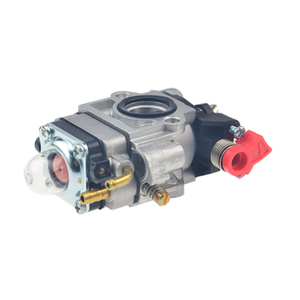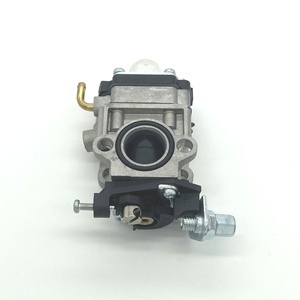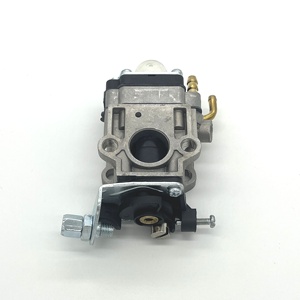Types of carburettors for 2-stroke engines
Carburettors are an essential part of any 2-stroke engine as they help to mix air with fuel to create a combustion reaction that helps to power the engine. There are several different types of carburettors for 2-stroke engines, including:
- Float carburettors: This is the most common type of carburettor for 2-stroke engines and is mostly used in internal combustion engines. The float carburettor uses a water body and a float to control the fuel level. When the fuel reaches the level of the float, it automatically shuts off the fuel supply. The float carburettor is mostly preferred because it is very reliable and simple to use.
- Chamber carburettors: This is another common type of carburettor used in 2-stroke engines. The well carburettor doesn't use a float but gets its fuel from a constant-pressure fuel supply. The fuel is always at a constant level in the well, and the carburettor's design controls the fuel draw. The fuel is drawn when a pressure difference occurs due to airflow. Well carburettors are mainly used in applications where fuel supply at a constant pressure is available.
- Slide carburettors: This type of carburettor is more common in 2-stroke engines that require precise control over the air-fuel mixture. The slide carburettor uses a sliding piston to regulate airflow through the carburettor. As the throttle opens, the piston slides up, increasing airflow and allowing more fuel to pass through the jet. This type of carburettor is ideal for applications that require a precise air-fuel mixture control.
- Diaphragm carburettors: These carburettors are mainly used in small 2-stroke engines, such as chainsaws and lawnmowers. The diaphragm carburettor uses a diaphragm to sense the pressure difference in the housing. The pressure difference moves the diaphragm, opening and closing the fuel metering chamber. This type of carburettor is very useful because it can accurately measure fuel at different engine speeds.
- Variable venturi carburettor: This type of carburettor can automatically adjust the venturi size in response to changes in airflow and throttle position. A movable element, such as a needle or piston, changes the venturi throat, maintaining the desired air-fuel ratio across different operating conditions. This ensures optimal performance and fuel efficiency in various engine speeds and loads.
Specifications and Maintenance of Carb. for 2 Stroke Engine
Many factors should be considered when buying carburetors for 2-stroke engines. Here are some specifications that buyers need to know.
-
Size
Carburetors come in different sizes that match various engine sizes. A larger carburetor allows more air and fuel, producing more power but at the expense of fuel efficiency.
-
Choke
Some carburetors have a choke, which provides quick starting in cold weather by enriching the fuel mixture.
-
Accelerator Pump
This feature delivers an extra fuel shot when the throttle opens, improving response and performance.
-
Adjustability
Adjustable carburetors allow users to change the air-fuel ratio, altitude, or exhaust modifications. Fixed carburetors have a pre-set ratio that suits standard conditions.
-
Material
Carburetors are generally made of metal or plastic. Those made of metal are more durable than plastic ones.
-
Brand
There are various brands of carburetors for 2-stroke engines, with each brand having its features. Users should choose a brand that suits their needs.
Maintaining carburetors for 2-stroke engines is very important. Proper maintenance helps increase the lifespan of carburetors and enhances their performance. Here are some maintenance tips.
-
Regular Cleaning
Carburetors should be cleaned regularly, preferably every few months. This helps remove dirt or debris that may clog the jets. Use a soft brush and carburetor cleaner to wash all parts.
-
Inspect Fuel Lines
The fuel lines should be checked every month to ensure there are no cracks or leaks. Damaged fuel lines can cause leaks, which is a fire hazard. Replace any worn or damaged fuel lines.
-
Use Quality Fuel
Avoid using lower quality fuel that contains more than 10% ethanol. Ethanol-rich fuel can harm carburetor parts over time. Always use fuel that complies with the manufacturer's recommendations.
-
Check Spark Plug
The spark plug should be inspected once every few months. A faulty spark plug can cause starting problems and poor engine performance. Replace the spark plug as recommended by the manufacturer.
-
Set the Air-Fuel Ratio
Ensure that the carburetor is properly adjusted to provide the right air-fuel mixture. A mixture that is too rich or too lean can damage the engine. Refer to the manufacturer's manual for the correct settings.
How to choose carb for 2 stroke engine
Choosing the right carburetor for a 2-stroke engine can be daunting. Here are some tips to help select the ideal carburetor for buyers' 2-stroke engines:
- Consider the engine's specifications: It's vital to consider the engine's specifications when choosing a carburetor. The carburetor should match the engine's power output and be able to handle the engine's displacement. For instance, a carburetor that is too large will cause the engine to run poorly, while one that is too small will limit the engine's power.
- Think about the intended use: Consider the intended use of the 2-stroke engine before choosing a carburetor. For example, buyers should use a carburetor that provides smooth and consistent power delivery if they use the engine in a chainsaw or other handheld equipment. On the other hand, a carburetor that delivers a more aggressive power band is ideal for carb. for 2-stroke motorcycle engines.
- Consider the brand and model: There are several brands and models of carburetors for 2-stroke engines on the market. It's vital to do some research and choose a reputable brand known for quality and durability. Also, selecting a model that is widely used and has good reviews is essential. This ensures that the carburetor will be available for many years and that any issues that arise have been well documented.
- Ease of installation and tuning: When choosing a carburetor for a 2-stroke engine, it's vital to consider the ease of installation and tuning. Some carburetors require more complex installation and tuning than others. If buyers are not comfortable with the installation and tuning process, it's important to choose a carburetor that is relatively easy to work with.
- Price: Price is an important factor to consider when choosing a carburetor for a 2-stroke engine. Carburetors are available in various price ranges, so choosing one that fits the budget is essential. However, it's vital to avoid going for the cheapest option, as this could mean sacrificing quality and durability.
How to DIY and replace Carburetors for 2 Stroke Engines
Replacing a carb for 2 stroke engine is a straightforward process that can be accomplished with some basic tools and mechanical knowledge. Here is a step-by-step guide on how to replace a carburetor on a 2-stroke engine:
Tools and Materials Needed:
- New carburetor compatible with the 2-stroke engine
- Screwdriver set
- Wrench set
- Pliers
- Fuel line cutter (if necessary)
- Fresh fuel
- Oil for carburetor maintenance
Step-by-Step Guide:
- 1. Disconnect the spark plug wire - This is to prevent any accidental starting of the engine while working on it.
- 2. Drain the fuel - Drain the fuel from the old carburetor using a fuel line or by removing the carburetor from the fuel lines.
- 3. Remove the air filter - Use a screwdriver or wrench to remove the air filter from the carburetor.
- 4. Disconnect the throttle linkage - Use a screwdriver or pliers to disconnect the throttle linkage from the carburetor.
- 5. Disconnect the fuel lines - Use a wrench or pliers to disconnect the fuel lines from the carburetor. If necessary, use a fuel line cutter to remove the carburetor from the fuel lines.
- 6. Remove the old carburetor - Use a wrench or screwdriver to remove the mounting bolts or nuts holding the carburetor in place. Carefully lift the carburetor out of the engine.
- 7. Install the new carburetor - Carefully place the new carburetor onto the engine, ensuring proper alignment with the intake manifold.
- 8. Reconnect the fuel lines - Use a wrench or pliers to reconnect the fuel lines to the new carburetor.
- 9. Reconnect the throttle linkage - Use a screwdriver or pliers to reconnect the throttle linkage to the new carburetor.
- 10. Install the air filter - Use a screwdriver or wrench to install the air filter onto the new carburetor.
- 11. Reconnect the spark plug wire - Reconnect the spark plug wire to the engine.
- 12. Refill the fuel tank - Refill the fuel tank with fresh fuel.
After completing these steps, the new carburetor should be installed and ready to use. It's always a good idea to consult the owner's manual for specific instructions and torque specifications for your particular engine model.
Q and A
Q1: How often should the carburetor be cleaned or adjusted?
A1: For users of 2-stroke carburetors, it is advisable to clean the carburetor at least once every 50 hours of operation or at the beginning of every busy season. However, if the device is not used frequently, it should be checked at least once every 6 months. For proper adjustments, users should consult the manufacturers' manuals.
Q2: What are some common problems with 2-stroke carburetors and how can they be fixed?
Carb. for 2 stroke engine have various problems that users should be aware of. First, the device may fail to start, which is mostly caused by fuel mixture problems, clogged jets, or air leaks. The solution is to check all the possible causes and rectify them. Secondly, the engine may run at high speeds, which could be due to incorrect carburetor settings, stuck throttle, or high fuel mixtures. All these can be fixed by adjusting the carburetor to the recommended settings by the manufacturer.
Other problems include rough running, which is caused by an incorrect fuel mixture, dirty carburetor, or faulty spark plugs. All these can be solved by cleaning the carburetor and replacing the spark plugs if they are faulty. The last problem is low power, which is caused by clogged air filters, exhaust restrictions, or carburetor issues. Users can fix this by cleaning the air filters and exhaust pipes.
Q3: Can I use ethanol-blended fuel in my 2-stroke carburetor?
Yes, users can use ethanol-blended fuels. However, they should ensure that the carburetor is compatible with the fuel. Ethanol provides better combustion but requires a minor adjustment in the fuel mixture.
Q4: How do I know if my carburetor needs replacement?
Some signs indicate a carburetor in bad shape. These signs include persistent issues that can't be solved by normal adjustments and minor cleanings, visible damage or wear, and decreased performance in engines. If users notice any of these signs, they should consult a professional mechanic to confirm if the carburetor needs replacement.
Q5: Can I adjust the carburetor myself?
Yes, adjusting the carb for 2-stroke engines is a task that can be done by anyone. However, for the adjustments to be done correctly, users should follow the instructions given in the manufacturer's manual. They can also watch online tutorials to guide them through the process.




















![[CX] <strong>2</strong> <strong>Stroke</strong> 4500 5200 5800 45cc 52cc 58cc High Quality Petrol ChainSaw <strong>Engine</strong> Carburettor MP16 Repackage](http://s.alicdn.com/@sc04/kf/H9e8a43a4427c46f4901ed02b7ff27fb2j.png_300x300.jpg)
![[CX] <strong>2</strong> <strong>Stroke</strong> 4500 5200 5800 45cc 52cc 58cc High Quality Petrol ChainSaw <strong>Engine</strong> Carburettor MP16 Repackage](http://s.alicdn.com/@sc04/kf/H2d542d31af794bdca36f2ee23f63aecaF.jpg_300x300.jpg)
![[CX] <strong>2</strong> <strong>Stroke</strong> 4500 5200 5800 45cc 52cc 58cc High Quality Petrol ChainSaw <strong>Engine</strong> Carburettor MP16 Repackage](http://s.alicdn.com/@sc04/kf/H27aa06f3a4dc4e1886ccdbb001505b62n.jpg_300x300.jpg)
![[CX] <strong>2</strong> <strong>Stroke</strong> 4500 5200 5800 45cc 52cc 58cc High Quality Petrol ChainSaw <strong>Engine</strong> Carburettor MP16 Repackage](http://s.alicdn.com/@sc04/kf/H715a4f7391674a7fa264607769a9ac00i.jpg_300x300.jpg)
![[CX] <strong>2</strong> <strong>Stroke</strong> 4500 5200 5800 45cc 52cc 58cc High Quality Petrol ChainSaw <strong>Engine</strong> Carburettor MP16 Repackage](http://s.alicdn.com/@sc04/kf/H93feaf9aef8d4a7c9df06c8e007f4cedG.jpg_300x300.jpg)
![[CX] <strong>2</strong> <strong>Stroke</strong> 4500 5200 5800 45cc 52cc 58cc High Quality Petrol ChainSaw <strong>Engine</strong> Carburettor MP16 Repackage](http://s.alicdn.com/@sc04/kf/H763a698b72b445fbbaed665bcf0cd967Q.jpg_300x300.jpg)






















































































































































































